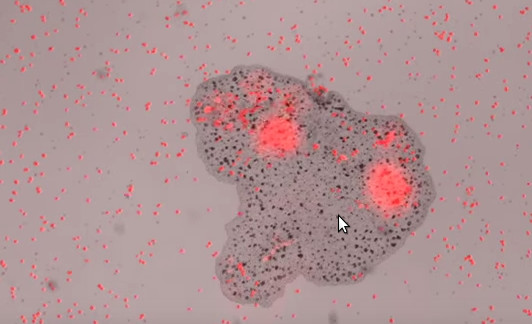Anomalous way of digesting organisms without organs
Eating for a non-organ body seems to be "impossible" . However, a marine animal has an unusual solution to overcome that challenge, using the upper body.
The diet of the species does not have organs
The discovery published in PLOS ONE shows that the lack of neurons, muscles and internal organs does not necessarily mean that organisms will not be able to perform complex behaviors.
"Despite having only 6 cell types and missing synapses, the Trichoplax scientific nomenclature has coordinated a complex sequence of behaviors, culminating in the digestion of algae. outside, "said Carolyn Smith of the National Institutes of Health, head of the new study.
German zoologist Franz Eilhard Schulze first discovered Trichoplax in 1883. He observed that it moved along the walls of an aquarium at the Zoological Institute in Graz, Austria. He described this tiny creature as a thin sheet of leaf hair.
Since then, this creature has been found all over the world, including the Red Sea, Mediterranean Sea, Caribbean, Hawaii, Guam, Samoa, Brazil, Australia, Japan, Vietnam and Papua. New Guinea.

The diet of Trichoplax marine animals does not have organs.(Snapshot from video).
Experts identify Trichoplax as a multicellular marine animal, but only owns 6 cell types. Meanwhile, humans possess about 200 different types of cells in the body.
Using high-tech electron microscopy and cell imaging, Smith's team carefully observed the body structure of Trichoplax as well as its behavior. They found that this creature has cilia to help line certain cells and vibrate into rhythmic waves. This helps it move here and there.
When approaching the food source (Trichoplax slides on an algae) , the cilia will stop vibrating, causing Trichoplax to stop. Gather one of its cell types, the lipophil, then secrete small particles to break down the algae so the body can easily absorb and absorb them.
After the "cup" is full, the Trichoplax slips away.
Because the body movement control seems to coordinate well with the precise control of the secretion of local digestive material, the researchers have identified that this organism has complex mechanisms for Information exchange and cell coordination. They also said that such a feeding method could represent one of the first digestive systems that ever appeared on Earth.
Experts hope, better understanding of this small animal can provide important insights for us about digestive evolution and early control systems.
- What is self-consumption? Some self-induced surgery? How long is the self-consumption time?
- Extinct because ... sex organs are too big
- Eating organs easily accumulates toxins but following these 3 ways will not be toxic
- How to eat organs from animals so that they do not have to be hospitalized?
- What kind of organs should be eaten
- Do not worry when the body has an extra spleen
- Russia fabricated only
- Raising the internal organs right in the living body of mice
- Robots can eat for energy like humans
- 7 human organs can be removed and still survive
- Taking organs of pigs to transplant for future people
- Detection of anomalous
 Animal 'suffering' after hibernation
Animal 'suffering' after hibernation Why do goats climb well?
Why do goats climb well? Scientists were surprised to see chimpanzees eating turtles
Scientists were surprised to see chimpanzees eating turtles Giant catfish died deadly due to drought in Thailand
Giant catfish died deadly due to drought in Thailand Why do cat eyes change 3 times a day?
Why do cat eyes change 3 times a day?  Why do birds sleep on branches without falling?
Why do birds sleep on branches without falling?  The monkey crossed 9,600km to find a mate
The monkey crossed 9,600km to find a mate  Decode the ability to climb walls of geckos
Decode the ability to climb walls of geckos  Chicken feathered orange
Chicken feathered orange  Spiders re-solidify and birds
Spiders re-solidify and birds 